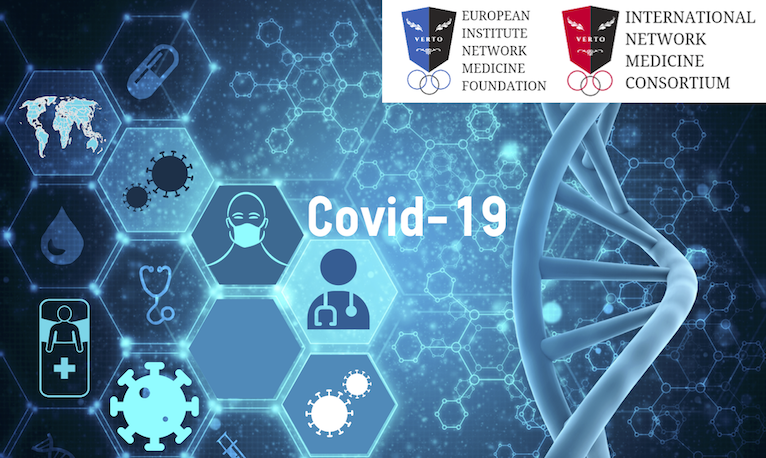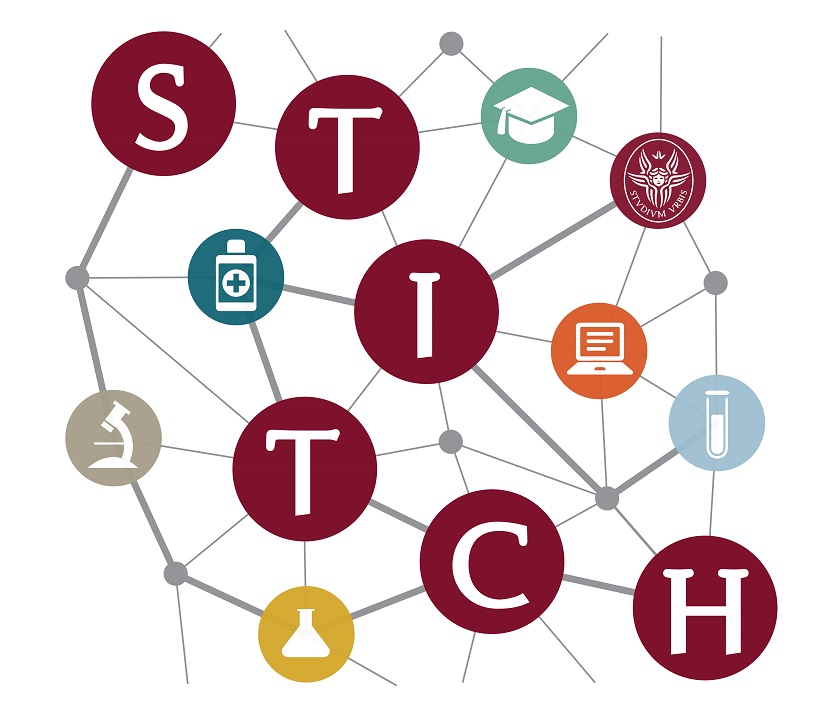Network Medicine Applied to Combat COVID-19 Disease

Mission
The International Network Medicine Consortium and Foundation are committed to improving global health and advancing the field of Network Medicine. Network Medicine combines principles and approaches from the network sciences, systems biology, and human dynamics to understand the causes of human diseases and develop new treatments. The challenge of controlling the SARS-CoV-2 virus and its varied disease manifestations will not be overcome by a single scientific discovery. The challenge calls for a multidisciplinary approach that draws from myriad disciplines such as network science, human dynamics, public health, computer science, and systems biology. Clinical and basic research have historically been tasked with the search for new antibodies, vaccines, and treatments. However, there are limits to these disciplines when the clinical outcomes of a disease don’t follow a predictable pattern or whose pattern is too complex to detect using conventional methods, which is the case for COVID-19. Clinical manifestations of COVID-19 fall along a broad spectrum ranging from asymptomatic to symptomatic to terminally-ill patients. Even in the subgroup of markedly symptomatic patients, the severity of outcomes, organ systems involved, and survival rates can vary widely. The timely addition of Network Medicine is needed to supplement clinical and basic research to better understand how patient demographics, genetics, medical history, and other factors contribute to the disparate outcomes seen among COVID-19 cases. And determining how contributing factors cluster together in specific patient subgroups may reveal more predictable patterns. Network Medicine is too promising to ignore and may be our best chance to determine which existing medications can effectively treat specific COVID-19 patient subgroups until a vaccine is developed and novel treatments are approved. The International Network Medicine Consortium and Foundation’s primary focus during these challenging times is to nurture the multidisciplinary interactions needed to combat COVID-19 and to spread our research, tools, and insights with private and public institutions around the world. |
Multinational Network Medicine Clinical Study to Combat COVID-19 (MNM COVID-19 Study)
The International Network Medicine Foundation and Consortium represents a network of 28 leading universities and academic medical centers in the US and Europe who are committed to improving global health and advancing the field of Network Medicine. Network Medicine combines principles and approaches from network sciences, systems biology, and human dynamics to understand the causes of human diseases and develop new treatments. We are united by a common goal, to bring an end to the COVID-19 global pandemic. COVID-19 presents a unique challenge. In addition to its rapid spread, the complexity of the SARS-CoV-2 virus and the varied outcomes of COVID-19 cases challenge what current clinical research is equipped to handle. So, we are leading a three-phase multinational Network Medicine clinical study (MNM COVID-19 study) to apply Network Medicine methodologies to study and effectively treat SARS-CoV-2 infected patients. The MNM COVID-19 study we designed has three phases:
|
MNM COVID-19 Study Executive Committee:
Joseph Loscalzo, MD, PhD Chairman BOD and Scientific Committee of the Foundation and Head of Consortium and Hersey Professor of the Theory and Practice of Medicine, Soma Weiss, MD, Distinguished. Chair in Medicine: Harvard Medical School. Chairman, Department of Medicine and Physician-in-Chief: Brigham and Women’s Hospital, USA Jan Baumbach, PhD Professor and Chair of Experimental Bioinformatic, Director of Information Technology (ITW), TUM School of Life Sciences (WZW), Technical University of Munich (TUM), Germany Eugenio Gaudio, MD Rettore of the Università, Professor of Medicine, Sapienza Università di Roma, Italy Sebastiano Filetti, MD Professor of Medicine, Delegate for International Relations Health Care, Sapienza Università di Roma, Italy Albert-Laszlo Barabasi, PhD Robert Gray Dodge Professor of Network Science, Distinguished University Professor, Director of Center for Complex Network Research, Dept. Of Physics, Northeastern University, Channing Division of Network Medicine, Brigham and Women’s Hospital, Harvard Medical School, USA, Director Network and Data Science, Central European University, Hungary Paolo Parini MD, PhD Professor, Senior Consultant, Director of Research & Development, Education and Innovation, Head of Inflammation and Infection, Karolinska University Hospital, Department of Medicine Karolinska Institutet at Huddinge University Hospital, Sweden Enrico Petrillo, MD Advisor to Chairman, Department of Medicine and Physician-in-Chief for International Research, Lead Investigator, Division of General Internal Medicine, Brigham and Women’s Hospital, Lecturer, Harvard Medical School |
Riposizionamento dei farmaci
Sebbene gli investimenti nel settore medico-farmaceutico siano notevolmente aumentati nell’ultimo ventennio, il numero di nuovi trattamenti, annualmente approvati dalla Food and Drug Administration (FDA) degli Stati Uniti, non è aumentato in modo significativo [1]. Le ragioni di tale andamento sono molteplici e complesse: lunghi tempi di ricerca (fase pre-clinica e clinica), alti costi, bassa probabilità di superare le fasi precoci della sperimentazione e accedere, quindi, alle fasi successive. Infatti, molti farmaci, soprattutto in ambito oncologico, presentano una significativa tossicità a fronte di una scarsa efficacia terapeutica [2]. La difficoltà della ricerca farmacologica è legata, inoltre, alla mancanza di approcci predittivi di farmaco-cinetica e farmaco-dinamica in grado di stabilire, con una certa accuratezza, profili di sicurezza e tollerabilità per le nuove entità chimiche. Il fenomeno del drug-repositioning sta cambiando lo scenario della ricerca biomedica orientata allo sviluppo di nuove soluzioni terapeutiche. Letteralmente traducibile come riposizionamento del farmaco, il drug-repositioning è l’insieme delle procedure volte a stabilire se un farmaco già noto possa essere utilizzato per il trattamento di patologie diverse da quelle a cui era stato inizialmente destinato. Il principio alla base del riposizionamento si basa su due evidenze scientifiche: 1) la scoperta che alcune malattie possano condividere target biologici comuni e 2) l’effetto pleiotropico dei farmaci [3]. Si tratta di una strategia terapeutica ormai molto diffusa perché rappresenta un’alternativa più rapida ed economica al normale iter di sviluppo di un nuovo farmaco. Se, infatti, per sviluppare una nuova molecola – dalla produzione all’approvazione, passando per le varie fasi della sperimentazione preclinica e clinica – occorrono generalmente 12-15 anni e 2-3 miliardi di dollari, per un progetto di drug-repositioning i costi si aggirano mediamente sui 300 milioni di dollari, in un periodo di tempo di 6-7 anni. Con il drug-repurposing, l’abbattimento dei tempi e costi di sperimentazione è dovuto al fatto che la formulazione dei farmaci è stata già sviluppata e la valutazione della sicurezza rigorosamente effettuata (si tratta, infatti, di farmaci già in commercio). Il bacino di farmaci a cui attingere è davvero vasto: da quelli di uso comune, già in commercio, a quelli ritenuti sicuri ma non efficaci sull’uomo per l’indicazione per la quale erano stati sviluppati. Un esempio è dato dall’aspirina: da tempo usata per la prevenzione cardiovascolare, ha recentemente mostrato un effetto protettivo nei confronti di vari tipi di neoplasie. La strategia del riposizionamento farmacologico coinvolge tre principali passaggi. 1) In primo luogo deve essere individuato il giusto farmaco, 2) deve essere valutato l’effetto in modelli clinici e 3) deve essere stimata l’utilità mediante trial clinici di fase II. Questi step vengono effettuati mediante approcci computazionali e sperimentali [2]. In particolare, gli approcci computazionali sono in grado di individuare e, dunque, predire nuove indicazioni terapeutiche per farmaci già esistenti, rappresentando lo strumento di base per fornire nuove ipotesi da testare. In particolare, tali approcci permettono di superare l’ipotesi, ormai datata, un gene-un farmaco-una malattia che, tenendo conto solo dei singoli obiettivi, impedisce la previsione degli effetti collaterali e della tossicità del farmaco (off-target toxicity), di effetti benefici inaspettati o di interazioni multiple con diversi bersagli farmacologici che portano ad una efficacia non ottimale [4,5]. Senza la piena conoscenza della rete delle interazioni dei determinanti molecolari della malattia e dei bersagli farmacologici nell’interattoma umano, non è possibile sviluppare approcci significativi per stabilire l'efficacia del trattamento di malattie complesse [6,7]. Ecco, quindi, che approcci computazionali basati sulla teoria delle reti e che partano dalla rete delle interazioni tra le singole componenti cellulari (i.e., l’interattoma umano), come quelli sviluppati da Barabási e Loscalzo [8] o da Zhou et al. [9], rappresentano un valido strumento per uno screening efficiente di potenziali nuove indicazioni per farmaci approvati con ben stabiliti profili di farmacocinetica e farmacodinamica, di sicurezza e tollerabilità o di eventi avversi precedentemente non identificati. Paola Paci Antonella Verrienti Rosa Falcone Marialuisa Sponziello STITCH-Sapienza References [1] Mullard, A. 2016 FDA drug approvals. Nat. Rev. Drug Discov. 16, 73–76 (2017) [2] Kirtonia A. et al. Repurposing of drugs: An attractive pharmacological strategy for cancer therapeutics Semin Cancer Biol 2020 May 4 [3] Jourdana JP et al. Drug repositioning: a brief overview. Journal of Pharmacy and Pharmacology 2020 Apr 17. [4] Shih, H. P., Zhang, X. & Aronov, A. M. Drug discovery effectiveness from the standpoint of therapeutic mechanisms and indications. Nat. Rev. Drug Discov. 17, 19–33 (2017) [5] Antman, E. M. & Loscalzo, J. Precision medicine in cardiology. Nat. Rev. Cardiol. 13, 591–602 (2016) [6] MacRae, C. A., Roden, D. M. & Loscalzo, J. The future of cardiovascular therapeutics. Circulation 133, 2610–2617 (2016) [7] Greene, J. A. & Loscalzo, J. Putting the patient back together - social medicine, network medicine, and the limits of reductionism. N. Engl. J. Med. 377, 2493–2499 (2017) [8] Cheng, F. et al. Network-based approach to prediction and population-based validation of in silico drug repurposing. Nat. Commun. 9, 2691 (2018) [9] Zhou, Y. et al. Network-based drug repurposing for novel coronavirus 2019-nCoV/SARS-CoV-2. Cell Discov. 6, 1–18 (2020) |


